Comparing the Effect of Isoinertial Flywheel Training and Traditional Resistance Training on Maximal Strength and Muscle Power in Healthy People: A Systematic Review and Meta-Analysis
Abstract
:1. Introduction
2. Methods
2.1. Search Strategy
2.2. Inclusion/Exclusion Criteria
2.3. Study Coding and Data Extraction
2.4. Quality Assessment
2.5. Statistics and Data Analysis
3. Results
3.1. Study Selection
3.2. Descriptive Characteristics of the Studies
3.3. Quality of the Selected Studies
3.4. Publication Bias and Sensitivity
3.5. Main Analysis
3.5.1. Meta-Analysis Results on Muscle Power
3.5.2. Meta-Analysis Results on Maximal Strength
3.6. Subgroup Analysis
3.6.1. Subject-Related Moderating Variables
3.6.2. Training-Related Programming Parameters
4. Discussion
4.1. Main Analysis
4.2. Subgroup Analysis
4.2.1. Total Number of Training Sessions
4.2.2. Strength Training Experience
4.2.3. Control Group’s Intervention
4.2.4. Selected Exercise
5. Limitations
6. Future Research Perspectives
7. Conclusions
Author Contributions
Funding
Institutional Review Board Statement
Informed Consent Statement
Data Availability Statement
Acknowledgments
Conflicts of Interest
References
- Schumann, M.; Feuerbacher, J.F.; Sunkeler, M.; Freitag, N.; Ronnestad, B.R.; Doma, K.; Lundberg, T.R. Compatibility of Concurrent Aerobic and Strength Training for Skeletal Muscle Size and Function: An Updated Systematic Review and Meta-Analysis. Sports Med. 2022, 52, 601–612. [Google Scholar] [CrossRef]
- Suchomel, T.J.; Nimphius, S.; Bellon, C.R.; Stone, M.H. The Importance of Muscular Strength: Training Considerations. Sports Med. 2018, 48, 765–785. [Google Scholar] [CrossRef] [PubMed]
- Ratamess, N.A.; Alvar, B.A.; Evetoch, T.E.; Housh, T.J.; Ben Kibler, W.; Kraemer, W.J.; Triplett, N.T. Progression Models in Resistance Training for Healthy Adults. Med. Sci. Sports Exerc. 2009, 41, 687–708. [Google Scholar] [CrossRef]
- Morris, S.J.; Oliver, J.L.; Pedley, J.S.; Haff, G.G.; Lloyd, R.S. Comparison of Weightlifting, Traditional Resistance Training and Plyometrics on Strength, Power and Speed: A Systematic Review with Meta-Analysis. Sports Med. 2022, 52, 1533–1554. [Google Scholar] [CrossRef] [PubMed]
- Roig, M.; O’Brien, K.; Kirk, G.; Murray, R.; McKinnon, P.; Shadgan, B.; Reid, W.D. The effects of eccentric versus concentric resistance training on muscle strength and mass in healthy adults: A systematic review with meta-analysis. Br. J. Sports Med. 2009, 43, 556–568. [Google Scholar] [CrossRef]
- Franchi, M.V.; Reeves, N.D.; Narici, M.V. Skeletal Muscle Remodeling in Response to Eccentric vs. Concentric Loading: Morphological, Molecular, and Metabolic Adaptations. Front. Physiol. 2017, 8, 447. [Google Scholar] [CrossRef] [PubMed]
- Sogaard, K.; Christensen, H.; Jensen, B.R.; Finsen, L.; Sjogaard, G. Motor control and kinetics during low level concentric and eccentric contractions in man. Electroencephalogr. Clin. Neurophysiol. 1996, 101, 453–460. [Google Scholar] [CrossRef]
- Gehlert, S.; Bloch, W.; Suhr, F. Ca2+-dependent regulations and signaling in skeletal muscle: From electro-mechanical coupling to adaptation. Int. J. Mol. Sci. 2015, 16, 1066–1095. [Google Scholar] [CrossRef]
- Hortobagyi, T.; Devita, P.; Money, J.; Barrier, J. Effects of standard and eccentric overload strength training in young women. Med. Sci. Sports Exerc. 2001, 33, 1206–1212. [Google Scholar] [CrossRef]
- Suchomel, T.J.; Wagle, J.P.; Douglas, J.; Taber, C.B.; Harden, M.; Haff, G.G.; Stone, M.H. Implementing Eccentric Resistance Training-Part 2: Practical Recommendations. J. Funct. Morphol. Kinesiol. 2019, 4, 55. [Google Scholar] [CrossRef]
- Patus, J. Accentuated Eccentric Loading is Superior to Traditional Loading for Improving Acute Countermovement Jump Performance in Adult, Resistance-Trained Males. J. Sport. Rehabil. 2021, 30, 956–960. [Google Scholar] [CrossRef] [PubMed]
- van den Tillaar, R.; Andersen, V.; Saeterbakken, A.H. The Existence of a Sticking Region in Free Weight Squats. J. Hum. Kinet. 2014, 42, 63–71. [Google Scholar] [CrossRef] [PubMed]
- Walker, S.; Blazevich, A.J.; Haff, G.; Tufano, J.J.; Newton, R.U.; Hakkinen, K. Greater Strength Gains after Training with Accentuated Eccentric than Traditional Isoinertial Loads in Already Strength-Trained Men. Front. Physiol. 2016, 7, 149. [Google Scholar] [CrossRef] [PubMed]
- Beato, M.; Dello Iacono, A. Implementing Flywheel (Isoinertial) Exercise in Strength Training: Current Evidence, Practical Recommendations, and Future Directions. Front. Physiol. 2020, 11, 569. [Google Scholar] [CrossRef] [PubMed]
- Monajati, A.; Larumbe-Zabala, E.; Goss-Sampson, M.; Naclerio, F. Injury Prevention Programs Based on Flywheel vs. Body Weight Resistance in Recreational Athletes. J. Strength. Cond. Res. 2021, 35 (Suppl. 1), S188–S196. [Google Scholar] [CrossRef] [PubMed]
- Timón, R.; Ponce-González, J.G.; González-Montesinos, J.L.; Olcina, G.; Pérez-Pérez, A.; Castro-Piñero, J. Inertial flywheel resistance training and muscle oxygen saturation. J. Sports Med. Phys. Fit. 2018, 58, 1618–1624. [Google Scholar] [CrossRef] [PubMed]
- Friedmann-Bette, B.; Bauer, T.; Kinscherf, R.; Vorwald, S.; Klute, K.; Bischoff, D.; Muller, H.; Weber, M.A.; Metz, J.; Kauczor, H.U.; et al. Effects of strength training with eccentric overload on muscle adaptation in male athletes. Eur. J. Appl. Physiol. 2010, 108, 821–836. [Google Scholar] [CrossRef] [PubMed]
- Buonsenso, A.; Centorbi, M.; Iuliano, E.; Di Martino, G.; Della Valle, C.; Fiorilli, G.; Calcagno, G.; di Cagno, A. A Systematic Review of Flywheel Training Effectiveness and Application on Sport Specific Performances. Sports 2023, 11, 76. [Google Scholar] [CrossRef]
- Tesch, P.A.; Fernandez-Gonzalo, R.; Lundberg, T.R. Clinical Applications of Iso-Inertial, Eccentric-Overload (YoYo) Resistance Exercise. Front. Physiol. 2017, 8, 241. [Google Scholar] [CrossRef]
- Xu, J.; Thompson, B.J.; Spencer, S.B.; Studenka, B.E.; Bressel, E. Effects of Flywheel Resistance Training on Muscle Function and Sport-specific Performance in Collegiate Club Water Polo Players. Res. Q. Exerc. Sport 2023, 94, 98–109. [Google Scholar] [CrossRef]
- Tseng, K.W.; Chen, J.R.; Chow, J.J.; Tseng, W.C.; Condello, G.; Tai, H.L.; Fu, S.K. Post-activation Performance Enhancement after a Bout of Accentuated Eccentric Loading in Collegiate Male Volleyball Players. Int. J. Environ. Res. Public Health 2021, 18, 13110. [Google Scholar] [CrossRef] [PubMed]
- Xie, H.; Zhang, W.; Chen, X.; He, J.; Lu, J.; Gao, Y.; Li, D.; Li, G.; Ji, H.; Sun, J. Flywheel eccentric overload exercises versus barbell half squats for basketball players: Which is better for induction of post-activation performance enhancement? PLoS ONE 2022, 17, e0277432. [Google Scholar] [CrossRef]
- Maroto-Izquierdo, S.; Bautista, I.J.; Martin Rivera, F. Post-activation performance enhancement (PAPE) after a single bout of high-intensity flywheel resistance training. Biol. Sport 2020, 37, 343–350. [Google Scholar] [CrossRef] [PubMed]
- Wagle, J.P.; Taber, C.B.; Cunanan, A.J.; Bingham, G.E.; Carroll, K.M.; DeWeese, B.H.; Sato, K.; Stone, M.H. Accentuated Eccentric Loading for Training and Performance: A Review. Sports Med. 2017, 47, 2473–2495. [Google Scholar] [CrossRef]
- Pecci, J.; Munoz-Lopez, A.; Jones, P.A.; Sanudo, B. Effects of 6 weeks in-season flywheel squat resistance training on strength, vertical jump, change of direction and sprint performance in professional female soccer players. Biol. Sport 2023, 40, 521–529. [Google Scholar] [CrossRef]
- Naczk, M.; Naczk, A.; Brzenczek-Owczarzak, W.; Arlet, J.; Adach, Z. Impact of inertial training on strength and power performance in young active men. J. Strength. Cond. Res. 2016, 30, 2107–2113. [Google Scholar] [CrossRef]
- Toien, T.; Pedersen Haglo, H.; Unhjem, R.; Hoff, J.; Wang, E. Maximal strength training: The impact of eccentric overload. J. Neurophysiol. 2018, 120, 2868–2876. [Google Scholar] [CrossRef] [PubMed]
- Vicens-Bordas, J.; Esteve, E.; Fort-Vanmeerhaeghe, A.; Bandholm, T.; Thorborg, K. Is inertial flywheel resistance training superior to gravity-dependent resistance training in improving muscle strength? A systematic review with meta-analyses. J. Sci. Med. Sport 2018, 21, 75–83. [Google Scholar] [CrossRef]
- Takkouche, B.; Norman, G. PRISMA statement. Epidemiology 2011, 22, 128. [Google Scholar] [CrossRef]
- Liberati, A.; Altman, D.G.; Tetzlaff, J.; Mulrow, C.; Gotzsche, P.C.; Ioannidis, J.P.A.; Clarke, M.; Devereaux, P.J.; Kleijnen, J.; Moher, D. The PRISMA Statement for Reporting Systematic Reviews and Meta-Analyses of Studies That Evaluate Health Care Interventions: Explanation and Elaboration. Ann. Intern. Med. 2009, 151, W65–W94. [Google Scholar] [CrossRef]
- Koo, T.K.; Li, M.Y. A Guideline of Selecting and Reporting Intraclass Correlation Coefficients for Reliability Research. J. Chiropr. Med. 2016, 15, 155–163. [Google Scholar] [CrossRef] [PubMed]
- Higgins, J.P.T.; Cochrane Collaboration. Cochrane Handbook for Systematic Reviews of Interventions, 2nd ed.; Wiley-Blackwell: Hoboken, NJ, USA, 2020. [Google Scholar]
- Cohen, J. Statistical Power Analysis for the Behavioral Sciences, 2nd ed.; L. Erlbaum Associates: Hillsdale, NJ, USA, 1988; 567p. [Google Scholar]
- Higgins, J.P.; Thompson, S.G.; Deeks, J.J.; Altman, D.G. Measuring inconsistency in meta-analyses. BMJ 2003, 327, 557–560. [Google Scholar] [CrossRef]
- Onambélé, G.L.; Maganaris, C.N.; Mian, O.S.; Tam, E.; Rejc, E.; McEwan, I.M.; Narici, M.V. Neuromuscular and balance responses to flywheel inertial versus weight training in older persons. J. Biomech. 2008, 41, 3133–3138. [Google Scholar] [CrossRef] [PubMed]
- Norrbrand, L.; Fluckey, J.D.; Pozzo, M.; Tesch, P.A. Resistance training using eccentric overload induces early adaptations in skeletal muscle size. Eur. J. Appl. Physiol. 2008, 102, 271–281. [Google Scholar] [CrossRef] [PubMed]
- Norrbrand, L.; Pozzo, M.; Tesch, P.A. Flywheel resistance training calls for greater eccentric muscle activation than weight training. Eur. J. Appl. Physiol. 2010, 110, 997–1005. [Google Scholar] [CrossRef] [PubMed]
- de Hoyo, M.; Pozzo, M.; Sanudo, B.; Carrasco, L.; Gonzalo-Skok, O.; Dominguez-Cobo, S.; Moran-Camacho, E. Effects of a 10-week in-season eccentric-overload training program on muscle-injury prevention and performance in junior elite soccer players. Int. J. Sports Physiol. Perform. 2015, 10, 46–52. [Google Scholar] [CrossRef] [PubMed]
- Maroto-Izquierdo, S.; Garcia-Lopez, D.; de Paz, J.A. Functional and Muscle-Size Effects of Flywheel Resistance Training with Eccentric-Overload in Professional Handball Players. J. Hum. Kinet. 2017, 60, 133–143. [Google Scholar] [CrossRef] [PubMed]
- Lundberg, T.R.; Garcia-Gutierrez, M.T.; Mandic, M.; Lilja, M.; Fernandez-Gonzalo, R. Regional and muscle-specific adaptations in knee extensor hypertrophy using flywheel versus conventional weight-stack resistance exercise. Appl. Physiol. Nutr. Metab. 2019, 44, 827–833. [Google Scholar] [CrossRef] [PubMed]
- Coratella, G.; Beato, M.; Ce, E.; Scurati, R.; Milanese, C.; Schena, F.; Esposito, F. Effects of in-season enhanced negative work-based vs traditional weight training on change of direction and hamstrings-to-quadriceps ratio in soccer players. Biol. Sport 2019, 36, 241–248. [Google Scholar] [CrossRef]
- Arsenis, S.; Gioftsidou, A.; Smilios, I.; Malliou, P.; Chatzinikolaou, A.O.; Gkogkos, D.; Beneka, A. The effects of flywheel training on the strength and power of lower limbs. Sport Sci. 2019, 12, 8–19. [Google Scholar]
- Cabanillas, R.; Serna, J.; Muñoz-Arroyave, V.; Ramos, J.A.E. Effect of eccentric overload through isoinertial technology in basketball players. Rev. Bras. Cineantropometria Desempenho Hum. 2020, 22, e59831. [Google Scholar] [CrossRef]
- Stojanovic, M.D.M.; Mikic, M.; Drid, P.; Calleja-Gonzalez, J.; Maksimovic, N.; Belegisanin, B.; Sekulovic, V. Greater Power but Not Strength Gains Using Flywheel Versus Equivolumed Traditional Strength Training in Junior Basketball Players. Int. J. Environ. Res. Public Health 2021, 18, 1181. [Google Scholar] [CrossRef] [PubMed]
- Murton, J.; Eager, R.; Drury, B. Comparison of flywheel versus traditional resistance training in elite academy male Rugby union players. Res. Sports Med. 2021, 31, 214–227. [Google Scholar] [CrossRef]
- Canos, J.; Corbi, F.; Colomar, J.; Cirer-Sastre, R.; Baiget, E. Effects of isoinertial or machine-based strength training on performance in tennis players. Biol. Sport 2022, 39, 505–513. [Google Scholar] [CrossRef] [PubMed]
- Weng, Y.; Liu, H.; Ruan, T.; Yang, W.; Wei, H.; Cui, Y.; Ho, I.M.K.; Li, Q. Effects of flywheel resistance training on the running economy of young male well-trained distance runners. Front. Physiol. 2022, 13, 1060640. [Google Scholar] [CrossRef]
- Madruga-Parera, M.; Bishop, C.; Fort-Vanmeerhaeghe, A.; Beato, M.; Gonzalo-Skok, O.; Romero-Rodriguez, D. Effects of 8 Weeks of Isoinertial vs. Cable-Resistance Training on Motor Skills Performance and Interlimb Asymmetries. J. Strength. Cond. Res. 2022, 36, 1200–1208. [Google Scholar] [CrossRef]
- Puustinen, J.; Venojarvi, M.; Haverinen, M.; Lundberg, T.R. Effects of Flywheel vs. Traditional Resistance Training on Neuromuscular Performance of Elite Ice Hockey Players. J. Strength. Cond. Res. 2023, 37, 136–140. [Google Scholar] [CrossRef]
- Banks, N.F.; Rogers, E.M.; Berry, A.C.; Jenkins, N.D.M. Progressive iso-inertial resistance exercise promotes more favorable cardiovascular adaptations than traditional resistance exercise in young adults. Am. J. Physiol. Heart Circ. Physiol. 2024, 326, H32–H43. [Google Scholar] [CrossRef]
- Walker, E.; Hernandez, A.V.; Kattan, M.W. Meta-analysis: Its strengths and limitations. Clevel. Clin. J. Med. 2008, 75, 431–439. [Google Scholar] [CrossRef]
- Maroto-Izquierdo, S.; Garcia-Lopez, D.; Fernandez-Gonzalo, R.; Moreira, O.C.; Gonzalez-Gallego, J.; de Paz, J.A. Skeletal muscle functional and structural adaptations after eccentric overload flywheel resistance training: A systematic review and meta-analysis. J. Sci. Med. Sport 2017, 20, 943–951. [Google Scholar] [CrossRef]
- de Keijzer, K.L.; Raya Gonzalez, J.; Beato, M. The effect of flywheel training on strength and physical capacities in sporting and healthy populations: An umbrella review. PLoS ONE 2022, 17, e0264375. [Google Scholar] [CrossRef] [PubMed]
- Sanchez, F.J.N.; de Villarreal, E.S. Does Flywheel Paradigm Training Improve Muscle Volume and Force? A Meta-Analysis. J. Strength. Cond. Res. 2017, 31, 3177–3186. [Google Scholar] [CrossRef]
- Hody, S.; Croisier, J.L.; Bury, T.; Rogister, B.; Leprince, P. Eccentric Muscle Contractions: Risks and Benefits. Front. Physiol. 2019, 10, 442082. [Google Scholar] [CrossRef] [PubMed]
- Ide, B.N.; Nunes, L.A.S.; Brenzikofer, R.; Macedo, D.V. Time Course of Muscle Damage and Inflammatory Responses to Resistance Training with Eccentric Overload in Trained Individuals. Mediat. Inflamm. 2013, 2013, 204942. [Google Scholar] [CrossRef]
- Fernandez-Gonzalo, R.; Lundberg, T.R.; Alvarez-Alvarez, L.; de Paz, J.A. Muscle damage responses and adaptations to eccentric-overload resistance exercise in men and women. Eur. J. Appl. Physiol. 2014, 114, 1075–1084. [Google Scholar] [CrossRef] [PubMed]
- Annibalini, G.; Contarelli, S.; Lucertini, F.; Guescini, M.; Maggio, S.; Ceccaroli, P.; Gervasi, M.; Ferri Marini, C.; Fardetti, F.; Grassi, E.; et al. Muscle and Systemic Molecular Responses to a Single Flywheel Based Iso-Inertial Training Session in Resistance-Trained Men. Front. Physiol. 2019, 10, 554. [Google Scholar] [CrossRef] [PubMed]
- Bishop, P.A.; Jones, E.; Woods, A.K. Recovery from Training: A Brief Review. J. Strength. Cond. Res. 2008, 22, 1015–1024. [Google Scholar] [CrossRef] [PubMed]
- Burt, D.G.; Lamb, K.; Nicholas, C.; Twist, C. Effects of exercise-induced muscle damage on resting metabolic rate, sub-maximal running and post-exercise oxygen consumption. Eur. J. Sport Sci. 2014, 14, 337–344. [Google Scholar] [CrossRef]
- Javier Núñez, F.; Suarez-Arrones, L.J.; Cater, P.; Mendez-Villanueva, A. The high-pull exercise: A comparison between a versapulley flywheel device and the free weight. Int. J. Sports Physiol. Perform. 2017, 12, 527–532. [Google Scholar] [CrossRef]
- Raeder, C.; Wiewelhove, T.; Westphal-Martinez, M.P.; Fernandez-Fernandez, J.; de Paula Simola, R.A.; Kellmann, M.; Meyer, T.; Pfeiffer, M.; Ferrauti, A. Neuromuscular Fatigue and Physiological Responses After Five Dynamic Squat Exercise Protocols. J. Strength. Cond. Res. 2016, 30, 953–965. [Google Scholar] [CrossRef]
- Suarez-Arrones, L.; Saez de Villarreal, E.; Nunez, F.J.; Di Salvo, V.; Petri, C.; Buccolini, A.; Maldonado, R.A.; Torreno, N.; Mendez-Villanueva, A. In-season eccentric-overload training in elite soccer players: Effects on body composition, strength and sprint performance. PLoS ONE 2018, 13, e0205332. [Google Scholar] [CrossRef]
- Sáez-Michea, E.; Alarcón-Rivera, M.; Valdés-Badilla, P.; Guzmán-Muñoz, E. Efectos de seis semanas de entrenamiento isoinercial sobre la capacidad de salto, velocidad de carrera y equilibrio postural dinámico./Effects of six weeks of isoinertial training on vertical jump performance, running velocity, and dynamic postural balance. Retos Nuevas Perspect. Educ. Física Deporte Recreación 2023, 48, 291–297. [Google Scholar] [CrossRef]
- Presland, J.D.; Timmins, R.G.; Bourne, M.N.; Williams, M.D.; Opar, D.A. The effect of Nordic hamstring exercise training volume on biceps femoris long head architectural adaptation. Scand. J. Med. Sci. Sports 2018, 28, 1775–1783. [Google Scholar] [CrossRef]
- Allen, W.J.C.; De Keijzer, K.L.; Raya-Gonzalez, J.; Castillo, D.; Coratella, G.; Beato, M. Chronic effects of flywheel training on physical capacities in soccer players: A systematic review. Res. Sports Med. 2023, 31, 228–248. [Google Scholar] [CrossRef]
- Tous-Fajardo, J.; Maldonado, R.A.; Quintana, J.M.; Pozzo, M.; Tesch, P.A. The Flywheel Leg-Curl Machine: Offering Eccentric Overload for Hamstring Development. Int. J. Sports Physiol. Perform. 2006, 1, 293–298. [Google Scholar] [CrossRef] [PubMed]
- Raya-Gonzalez, J.; Castillo, D.; de Keijzer, K.L.; Beato, M. Considerations to Optimize Strength and Muscle Mass Gains Through Flywheel Resistance Devices: A Narrative Review. Strength. Cond. J. 2023, 45, 111–121. [Google Scholar] [CrossRef]
- Muñoz-López, A.; Nakamura, F.Y. Measuring and Testing with Flywheel Resistance Training Devices. In Resistance Training Methods; Lecture Notes in Bioengineering; Springer: Cham, Switzerland, 2022; pp. 181–194. [Google Scholar]
- Sagelv, E.H.; Pedersen, S.; Nilsen, L.P.R.; Casolo, A.; Welde, B.; Randers, M.B.; Pettersen, S.A. Flywheel squats versus free weight high load squats for improving high velocity movements in football. A randomized controlled trial. BMC Sports Sci. Med. Rehabil. 2020, 12, 61. [Google Scholar] [CrossRef]
- Alkner, B.A.; Bring, D.K.I. Muscle Activation During Gravity-Independent Resistance Exercise Compared to Common Exercises. Aerosp. Med. Hum. Perform. 2019, 90, 506–512. [Google Scholar] [CrossRef]
- Suchomel, T.J.; Wagle, J.P.; Douglas, J.; Taber, C.B.; Harden, M.; Haff, G.G.; Stone, M.H. Implementing Eccentric Resistance Training-Part 1: A Brief Review of Existing Methods. J. Funct. Morphol. Kinesiol. 2019, 4, 38. [Google Scholar] [CrossRef]
- Petré, H.; Wernstål, F.; Mattsson, C.M. Effects of Flywheel Training on Strength-Related Variables: A Meta-analysis. Sports Med. Open 2018, 4, 55. [Google Scholar] [CrossRef]
- Cokorilo, N.; Horvatin, M.; Dordevic, D.; Stankovic, M.; Pekas, D. Flywheel Training in Older Adults-A Systematic Review. Sustainability 2022, 14, 4137. [Google Scholar] [CrossRef]
- Maroto-Izquierdo, S.; Fernandez-Gonzalo, R.; Magdi, H.R.; Manzano-Rodriguez, S.; Gonzalez-Gallego, J.; De Paz, J.A. Comparison of the musculoskeletal effects of different iso-inertial resistance training modalities: Flywheel vs. electric-motor. Eur. J. Sport Sci. 2019, 19, 1184–1194. [Google Scholar] [CrossRef] [PubMed]
- Martinez-Aranda, L.M.; Fernandez-Gonzalo, R. Effects of Inertial Setting on Power, Force, Work, and Eccentric Overload During Flywheel Resistance Exercise in Women and Men. J. Strength. Cond. Res. 2017, 31, 1653–1661. [Google Scholar] [CrossRef] [PubMed]
- Sabido, R.; Hernández-Davó, J.L.; Capdepon, L.; Tous-Fajardo, J. How Are Mechanical, Physiological, and Perceptual Variables Affected by the Rest Interval Between Sets During a Flywheel Resistance Session? Front. Physiol. 2020, 11, 663. [Google Scholar] [CrossRef]
- Chiu, L.Z.F.; Salem, G.J. Comparison of joint kinetics during free weight and flywheel resistance exercise. J. Strength. Cond. Res. 2006, 20, 555–562. [Google Scholar]
- Newton, R.U.; Murphy, A.J.; Humphries, B.J.; Wilson, G.J.; Kraemer, W.J.; Häkkinen, K. Influence of load and stretch shortening cycle on the kinematics, kinetics and muscle activation that occurs during explosive upper-body movements. Eur. J. Appl. Physiol. Occup. Physiol. 1997, 75, 333–342. [Google Scholar] [CrossRef]


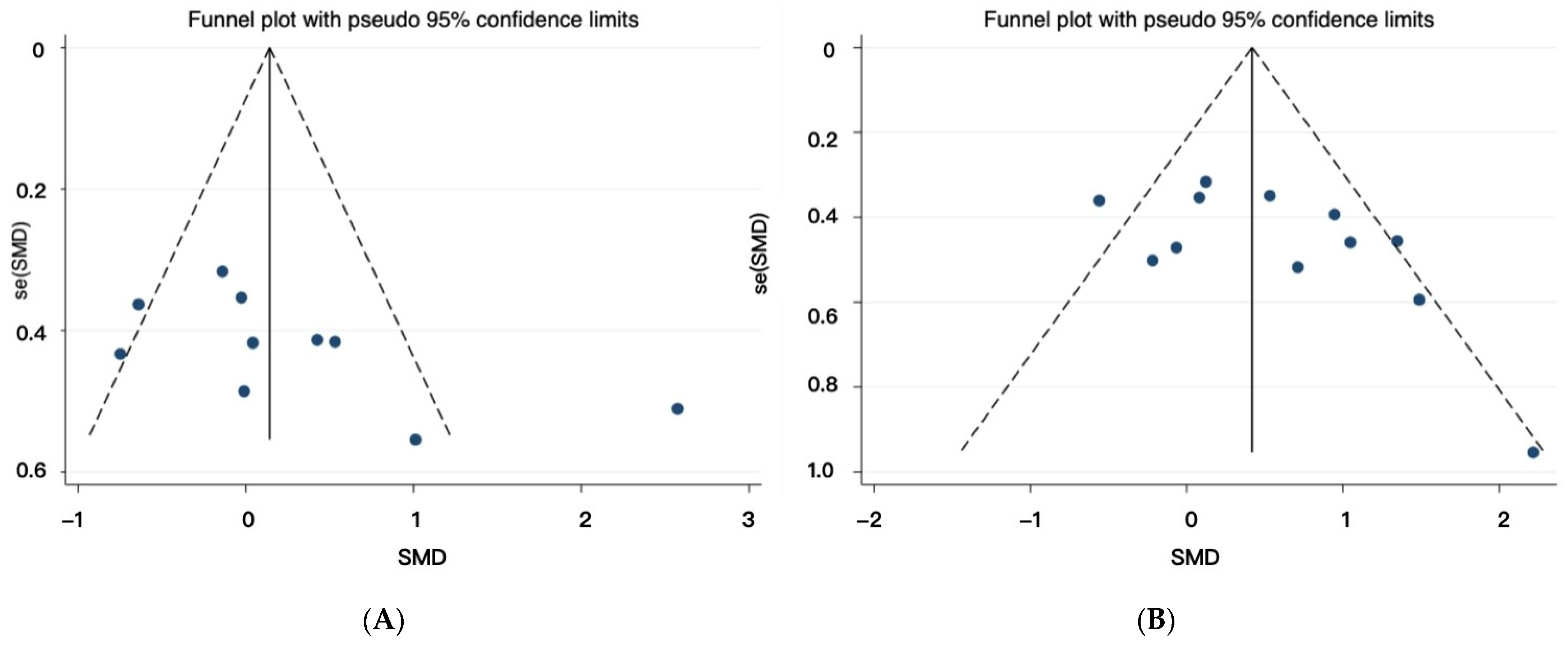
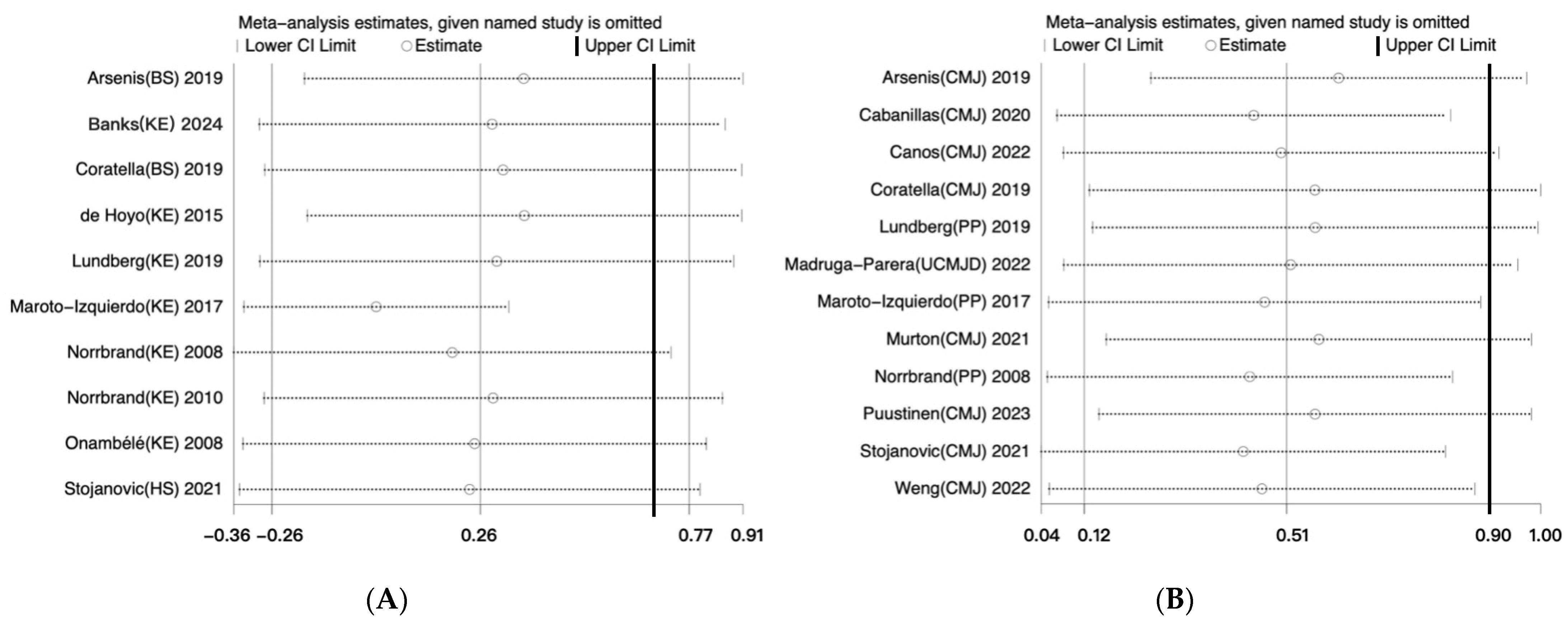


 effect size of individual studies.
effect size of individual studies.  combined effect size.
combined effect size.
 effect size of individual studies.
effect size of individual studies.  combined effect size.
combined effect size.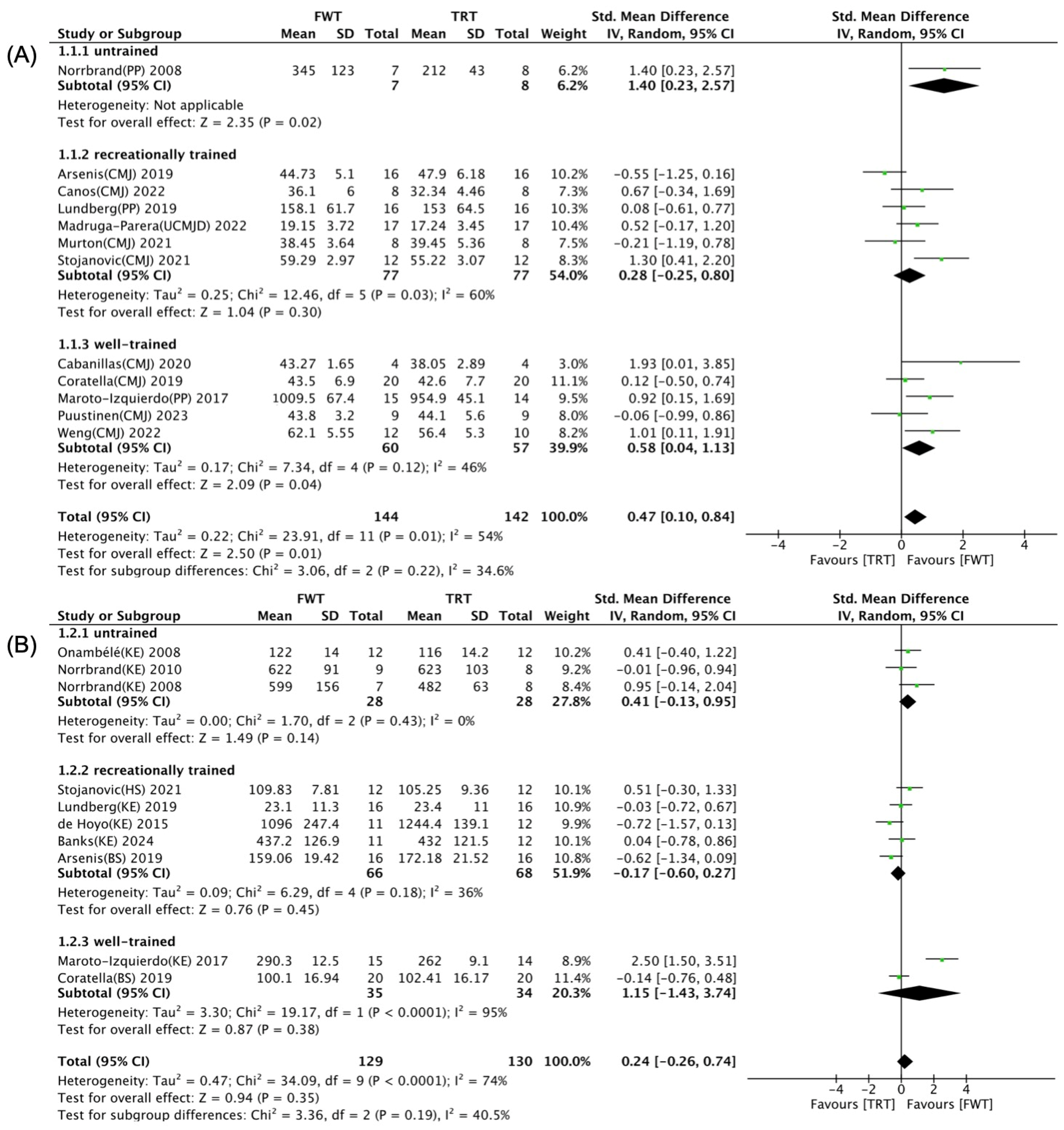
 effect size of individual studies.
effect size of individual studies.  combined effect size.
combined effect size.
 effect size of individual studies.
effect size of individual studies.  combined effect size.
combined effect size.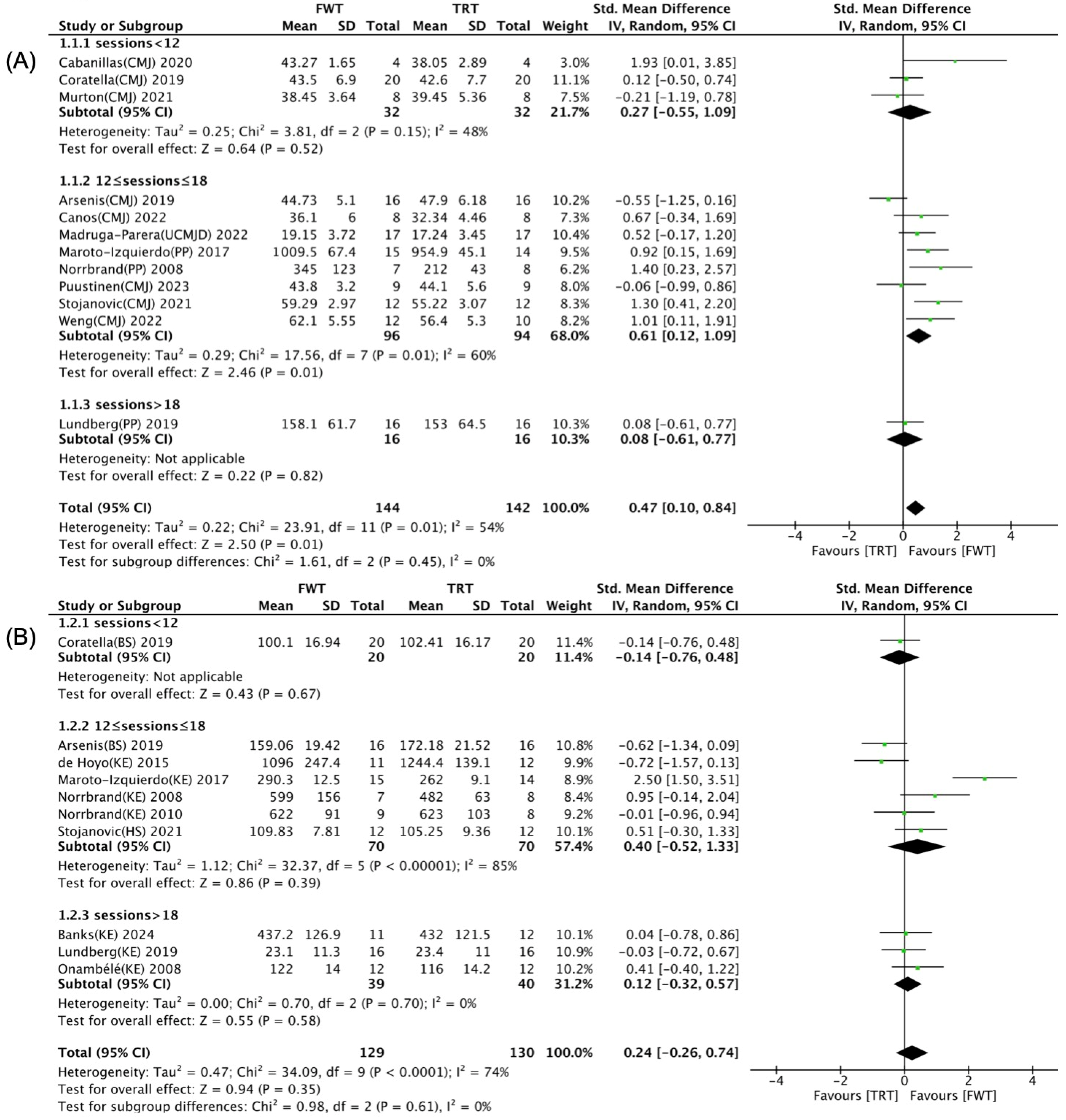
 effect size of individual studies.
effect size of individual studies.  combined effect size.
combined effect size.
 effect size of individual studies.
effect size of individual studies.  combined effect size.
combined effect size.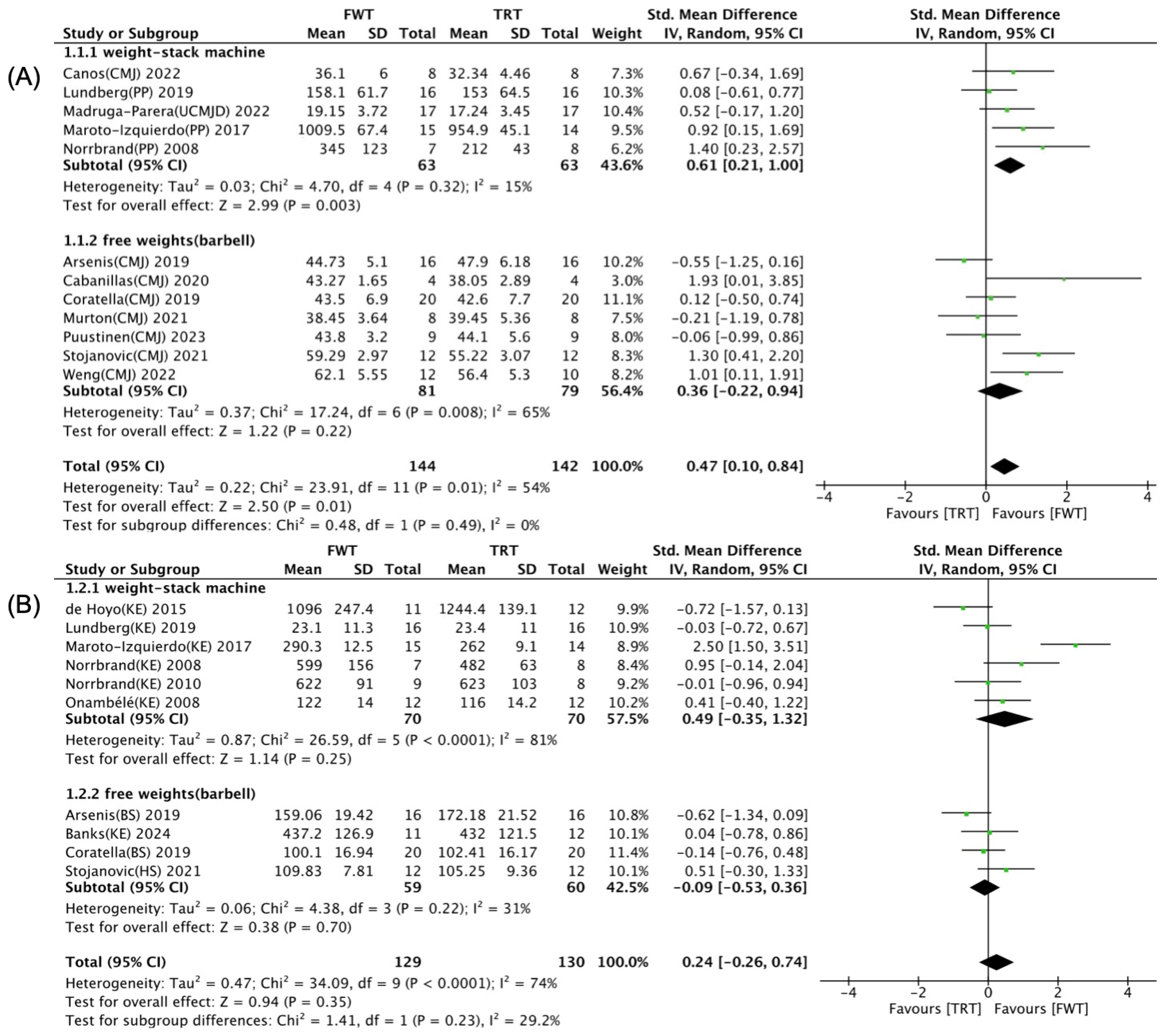
 effect size of individual studies.
effect size of individual studies.  combined effect size.
combined effect size.
| Study (Year) | Characteristics of Participants | Intervention | Results | ||||||||
|---|---|---|---|---|---|---|---|---|---|---|---|
| N (M/F) | Height (cm) | Weight (kg) | Age (y) | Training Experience | Exercise (Experimental Group Equipment) | Set × Reps | Frequency × Duration = Sessions | Control Group Intensity | Experimental Group Intensity | ||
| [35] | 12/12 | — | — | 69.8 ± 1.3 | untrained | knee extension (YoYo flywheel device) | 1–4 × 8–12 | 3 × 12 = 36 | 80%1 RM | — | MVC ↑ 8%; PT ↑ 28.0% (*) |
| [36] | 15/0 | 182.8 ± 7.7 | 91.0 ± 13.8 | 39.3 ± 8.6 | untrained | knee extension (YoYo flywheel device) | 4 × 7 | 2–3 × 5 = 12 | 7 RM | 7 RM | Con PP ↑ 9.0%; ECC PP 12.0%; MVC ↑ 11.6% (*) |
| [37] | 17/0 | 185.2 ± 8.1 | 90.0 ± 15.8 | 39.1 ± 6.6 | untrained | knee extension (YoYo flywheel device) | 4 × 7 | 2–3 × 5 = 12 | 7 RM | 7 RM | MVC ↑ 8.1% (*) |
| [38] | 23/0 | 176.8 ± 3.34 | 76.8 ± 7.83 | 22.5 ± 2.5 | RT (physically active males) | front step exercise (inertial flywheel device) | 5–7 × 8 | 3 × 6 = 18 | 8 RM | 8 RM | MVC ↑ 11.0% |
| [39] | 29/0 | 185.0 ± 5.9 | 83.9 ± 3.9 | 21.7 ± 2.7 | WT (professional handball players) | leg-press (YoYo flywheel device) | 4 × 7 | 2–3 × 6 = 15 | 7 RM | 7 RM | CMJ height ↑ 9.8% (*); PP ↑ 12.9% (*); 1 RM ↑ 12.2% |
| [40] | 8/8 | 173.0 ± 13.0 | 79.0 ± 22.0 | 26.0 ± 4.0 | RT (recreationally active individuals) | unilateral knee extension (YoYo flywheel device) | 4 × 7 | 2–3 × 8 = 20 | 8–12 RM | 7 RM | PP ↑ 29.2%; 1 RM ↑ 25.3% |
| [41] | 40/0 | 180.0 ± 11.0 | 77.0 ± 5.0 | 23 ± 4 | WT (Italian fourth-division soccer players) | squat (Desmotec flywheel device) | 4–6 × 8 | 1 × 8 = 8 | 80%1 RM | 8 RM | CMJ height ↑ 10%; BS 1 RM ↑ 7% |
| [42] | 32/0 | 177.6 ± 5.4 | 75.9 ± 7.6 | 21.0 ± 1.4 | RT (amateur soccer student players) | half squat (Desmotec flywheel device) | 3–4 × 5 or 3–6 × 6 | 2 × 8 = 16 | — | 5 or 6 RM | CMJ height↑ 4.0%; 1 RM ↑ 9.7% |
| [43] | 8/0 | 193.5 ± 8.0 | 87.4 ± 11.7 | 21.3 ± 3.5 | WT (professional basketball players) | half squat (inertial flywheel device) | 4–6 × 10 | 1 × 6 = 6 | 14 RM | 10 RM | CMJ height ↑ (*) |
| [44] | 24/0 | 190.6 ± 5.9 | 77.2 ± 7.0 | 17.6 ± 0.6 | RT (junior basketball players) | half squat, Romanian deadlift (isoinertial flywheel device) | 2–4 × 8 | 1–2 × 8 = 12 | 80%1 RM | 8 RM | CMJ height ↑ 11.7% (*); MVC ↑ 18.7% |
| [45] | 16/0 | — | 93.0 ± 13.1 | 18.0 ± 1.0 | RT (academy rugby union players) | squat, Romanian deadlift, Bulgarian split squat (kbox flywheel device) | 4–5 × 6 or 8 | 2 × 4 = 8 | 6 RM or 8 RM | 6 RM or 8 RM | CMJ PP ↑ 4.0%; CMJ height ↑ 4.9% |
| [46] | 16/0 | 174.4 ± 7.8 | 64.5 ± 8.6 | 15.5 ± 1.2 | RT (junior tennis players) | chest press, shoulder press, row, closed stance, and chest crossover (isoinertial flywheel device) | 3 × 6 or 8 | 2 × 8 = 16 | 50–70% 1 RM | RPE 5–7 | CMJ height ↑ 9.7% (*) |
| [47] | 22/0 | 178.0 ± 1.8 | 71.5 ± 6.9 | 21.8 ± 2.7 | WT (elite collegiate long-distance runners) | squat (kbox flywheel device) | 4 × 7 | 3 × 6 = 18 | 85%1 RM | 7 RM | CMJ height ↑ 12.0 (*) |
| [48] | 34/0 | 174.0 ± 7.3 | 70.5 ± 13.3 | 16.0 ± 1.4 | RT (junior handball players) | lunge, acceleration, squat, single leg hop, and crossover step (isoinertial flywheel device) | 3 × 8 or 12 | 2 × 8 = 16 | RPE 6–9 | RPE 6–9 | UCMJD height ↑ 21.9% |
| [49] | 18/0 | 184.1 ± 9.7 | 78.9 ± 10.0 | 18.6 ± 0.8 | WT (elite hockey players) | bilateral/unilateral squat, leg curl, and leg press (isoinertial flywheel device) | 3–4 × 6 or 4 × 7 | 1–2 × 8 = 14 | 4–12 RM | 6 or 7 RM | CMJ height ↑ 5.7% |
| [50] | 11/12 | 170.0 ± 2.0 | 73.8 ± 15.9 | 24.15 ± 3.9 | RT (physically active adults) | squat, bench press, deadlift, and row (flywheel training platform) | 3 × 4–12 | 3 × 10 = 30 | — | — | MVIT ↑ 11.4 |
Disclaimer/Publisher’s Note: The statements, opinions and data contained in all publications are solely those of the individual author(s) and contributor(s) and not of MDPI and/or the editor(s). MDPI and/or the editor(s) disclaim responsibility for any injury to people or property resulting from any ideas, methods, instructions or products referred to in the content. |
© 2024 by the authors. Licensee MDPI, Basel, Switzerland. This article is an open access article distributed under the terms and conditions of the Creative Commons Attribution (CC BY) license (https://creativecommons.org/licenses/by/4.0/).
Share and Cite
Hu, Z.; Liu, Y.; Huang, K.; Huang, H.; Li, F.; Yuan, X. Comparing the Effect of Isoinertial Flywheel Training and Traditional Resistance Training on Maximal Strength and Muscle Power in Healthy People: A Systematic Review and Meta-Analysis. Life 2024, 14, 908. https://doi.org/10.3390/life14070908
Hu Z, Liu Y, Huang K, Huang H, Li F, Yuan X. Comparing the Effect of Isoinertial Flywheel Training and Traditional Resistance Training on Maximal Strength and Muscle Power in Healthy People: A Systematic Review and Meta-Analysis. Life. 2024; 14(7):908. https://doi.org/10.3390/life14070908
Chicago/Turabian StyleHu, Zhongzhong, Yuhang Liu, Keke Huang, Hao Huang, Feng Li, and Xiaoyi Yuan. 2024. "Comparing the Effect of Isoinertial Flywheel Training and Traditional Resistance Training on Maximal Strength and Muscle Power in Healthy People: A Systematic Review and Meta-Analysis" Life 14, no. 7: 908. https://doi.org/10.3390/life14070908
APA StyleHu, Z., Liu, Y., Huang, K., Huang, H., Li, F., & Yuan, X. (2024). Comparing the Effect of Isoinertial Flywheel Training and Traditional Resistance Training on Maximal Strength and Muscle Power in Healthy People: A Systematic Review and Meta-Analysis. Life, 14(7), 908. https://doi.org/10.3390/life14070908







